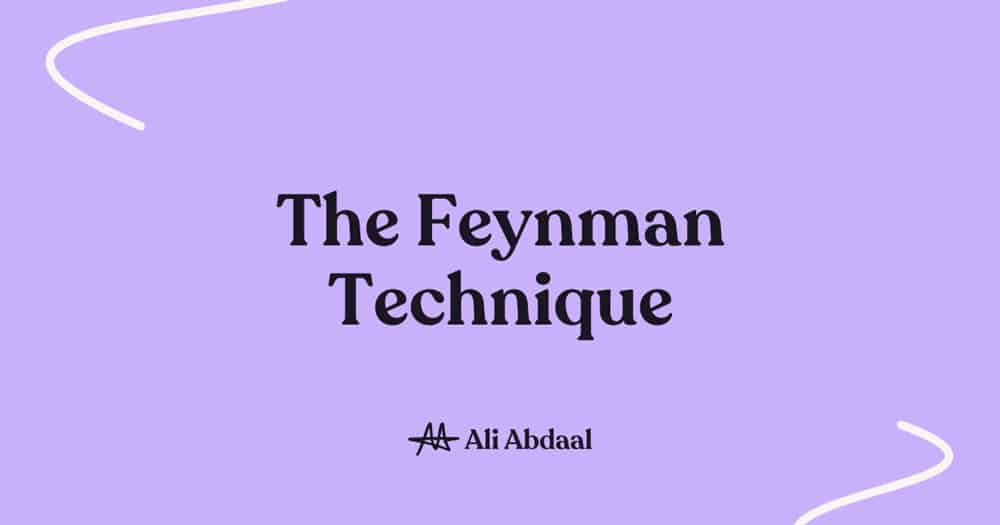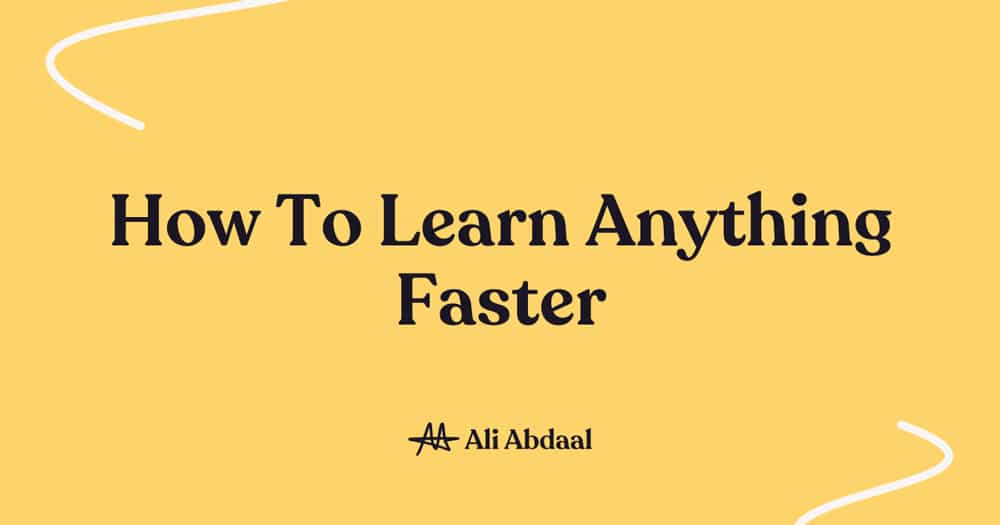“If you can’t explain it simply, you don’t understand it well enough” – Albert Einstein (attributed)
When we learn something, it’s easy to convince ourselves that we’ve understood it too. But, are we really learning effectively? Have we understood the concept or simply memorised some sentences?
The problem with the learning techniques most of us use (like highlighting, summarising, and rereading) is that, although they feel intuitively productive, they’re not very effective or useful in improving knowledge retention. So instead of using techniques that will help our knowledge to compound over time, we’re essentially resorting to learning hacks that help us quickly pass a test. This is a trap we’ve all fallen into at some point. I know I certainly have.
Fortunately, this is where the Feynman technique can help.
👨🏫 The Greatest Teacher I Never Had
During his lifetime, he pioneered the field of quantum electrodynamics, re-invented our understanding of particle physics through his visual representation of subatomic particles, and won the 1965 Nobel Prize in physics. Beyond theoretical physics, he was an influential figure in the Manhattan Project, wrote a detailed report on the causes of the Space Shuttle Challenger disaster, and had an incredible ability to communicate complex ideas with clarity and simplicity.
His name was Richard Feynman.
But it wasn’t his innate intelligence that made Feynman so brilliant (at least, according to the man himself). Rather, it was his systematic method of understanding, simplifying, and explaining difficult concepts that contributed far more to his eventual success.
This method is now called ‘The Feynman Technique’.

🤓 The Feynman Technique
The Feynman technique is based around the idea that one of the most effective techniques to enhance our understanding is to imagine that we’re teaching the material to someone who has absolutely no idea about the topic. Like a small child.
By doing this, we force ourselves to explain our thoughts fully and avoid glossing over topics we don’t understand well enough. Through the 4-steps of the Feynman technique I’ve outlined below, we’re encouraged to identify our knowledge gaps, reorganise our thoughts, and ultimately improve our long-term retention of that knowledge.
- Identify the topic
- Teach it to a child
- Identify knowledge gaps
- Simplify
We’ll look at each of these steps in turn.
1. Identify the Topic
The first step is to choose a topic we’ve recently studied and/or a topic we’d like to test our knowledge and understanding. This can literally be any topic we want.
My recommendation is to grab a piece of paper and write this topic clearly at the top of the page. Try not to pick a topic that’s too broad (e.g. “medicine”) otherwise it’s going to be impossible to do step 2 properly. Just identify a topic that’s narrow enough to explain in no more than 5 minutes.
What are the learning benefits of identifying the topic?
- It makes learning specific – our focus is on one topic area, rather than an entire subject. So we know exactly what we have to know/learn.
- It keeps things simple – learning a smaller, more specific, topic makes it far quicker to complete the 4 steps of the Feynman technique. So we’re less likely to get bored or give up while learning/revising.
- We face our weaknesses – when we memorise it’s easy for us to skip over things we don’t enjoy. But by identifying our topic we’re facing our weaknesses and forced to confront what we don’t know.
2. Teach it to a Child
Pretend we’re teaching and explaining the topic to a small child or someone who’s never come across the topic before. The key here is simplicity – explain the concept using simple language. Don’t simply define the concept but, if it is a mathematical concept for instance, work through examples to show how the concept works in practice.
“The first principle is that you must not fool yourself and you are the easiest person to fool” – Richard Feynman
The classic mistake is to treat learning as a passive process. Rereading and highlighting are particularly popular learning techniques, but they’re largely ineffective because we’re not actually engaging with the material in any meaningful way. Teaching, on the other hand, is an active method of learning that is far more effective. After all, we can’t teach something without first understanding it properly.
My advice – take your piece of paper and explain your chosen topic in detail in your own words. Try to keep it brief, avoid technical jargon, and use example/analogies wherever possible.
What are the learning benefits of teaching the topic?
- There’s no hiding – when we teach a topic, we can’t shy away from the things we don’t know. If there’s a gap in our knowledge, we’ll quickly find it. Remember: teaching is a feedback loop for finding what we don’t know, not for explaining what we do know.
- We get external feedback – when we learn through note taking it’s very difficult for us to tell when we’ve learnt something sufficiently well. But, when we try to explain a topic to someone else, they’ll often let us know if they don’t understand something or if our explanation needs further simplification.
3. Identify Knowledge Gaps
In step three, we need to pinpoint the areas we found difficult to explain or had to return to our notes/textbooks to refresh our understanding. If we had to use any technical term in our explanation, we should challenge ourselves to break those terms into simpler components.
If a child would struggle to understand us, we’ve found a knowledge gap that needs to be filled and simplified in step 4. The key is not only to identify complex areas of our own explanations but also to challenge and identify where we’ve made assumptions based on what we already understand intuitively. A child won’t intuitively know much about our topic, so we need to make sure our explanations strip things back to the basics.
What are the learning benefits of identifying knowledge gaps?
- It is an active way to learn – by identifying where we’re struggling, we become more intentional about our learning. Instead of covering the stuff we already know (like we do when we reread, highlight, and summarise), we automatically focus our attention on the topics that need the most work.
- Learning is iterative – it’s impossible to remember a topic if we only look at it once. The Feynman technique, however, rewards repetition. By teaching a topic and filling in knowledge gaps multiple times, we’re more likely to encode this knowledge into our long-term memory.
4. Simplify
The final step of the Feynman technique is to rewrite our explanation of a topic in simpler terms. This often involves re-organising our thoughts so the explanation flows more naturally, finishing incomplete thoughts, and finding simpler examples to break down complex ideas. This may take some time (or may have to be done multiple times) to get right.
What are the learning benefits of simplifying?
- Understanding starts with simplicity – we don’t understand something unless we can explain it simply. Using technical language or assuming our listener has an existing baseline of knowledge means we’re probably relying on memorisation, rather than understanding.
- We build confidence – if we’re able to teach someone a topic we previously found confusing, it boosts our confidence and encourages us to learn even more.
💡 Why use the Feynman Technique?
Although it appears to be a simple technique, it’s highly effective.
The technique enables us to quickly overview a concept, identify areas that are weaker and, critically, requires active learning – we are forced to move beyond passively rereading or highlighting and actively think about how we would explain a particular concept in simple terms.
It also automatically removes memorisation from our learning process. In school, we memorise pretty much everything and quickly forget it all once we’ve finished our exams. But the Feynman technique goes much further, expecting us to prove our understanding of a given topic and clarify our thoughts.
Finally, the Feynman technique pushes us to explore topics that interest us more deeply. And this is the essence of learning anything: be curious and fall in love with what you’re learning. If we can have fun and enjoy the journey, then the learning will take care of itself.
“Fall in love with some activity, and do it! Nobody ever figures out what life is all about, and it doesn’t matter. Explore the world. Nearly everything is really interesting if you go into it deeply enough. Work as hard and as much as you want to on the things you like to do the best. Don’t think about what you want to be, but what you want to do. Keep up some kind of a minimum with other things so that society doesn’t stop you from doing anything at all” – Richard Feynman
👋 Conclusion
If we want to learn more effectively and deepen our understanding of a topic, there’s really no better method than the Feynman technique. Every student should add it to their armoury of revision tools. In fact, every learner should leverage it to enhance understanding, increase productivity, and improve performance. It’s genuinely so useful regardless of what we’re looking to learn.
Alongside the Feynman technique there are a bunch of other well-kept secrets on how to study effectively. Stuff we’re never really taught how to do at school.


